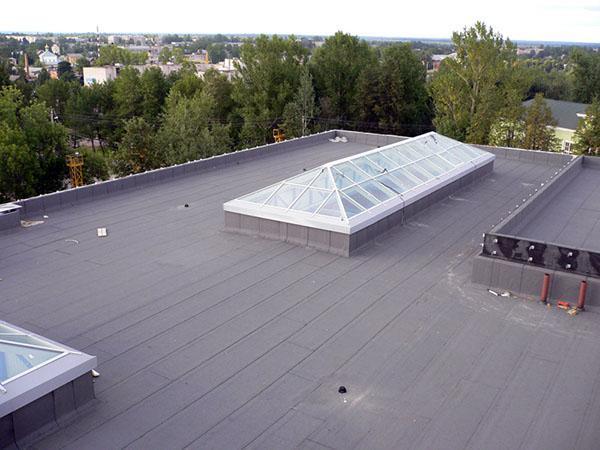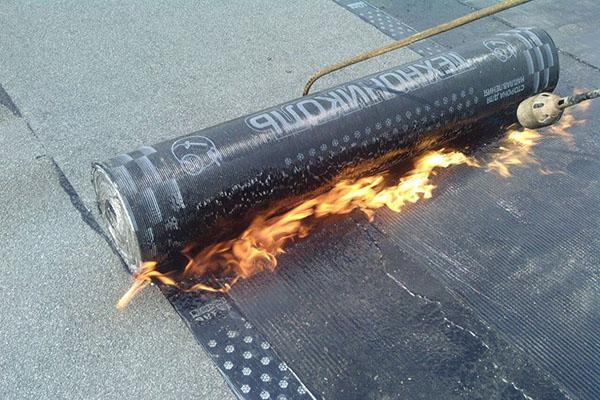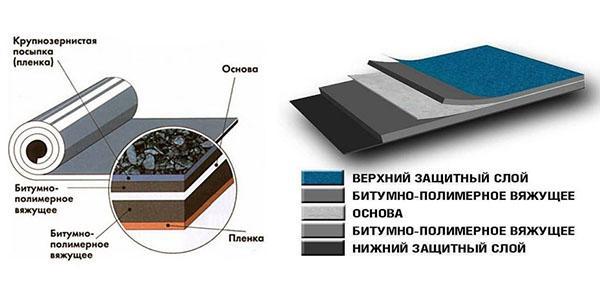What is a roof made of weldable materials
 A roof made of fusing materials is equipped with rolls of non-woven material (building board, fiberglass, polyester) covered with bitumen or polymer-bitumen material, which, when heated with a gas burner, fuses the roll to the roof. The outer surface is dense to protect it from mechanical stress, it is sprinkled with crumbs of stone slate, mica or sand. The deposited layer is covered with an indicator film. It burns out when heated and signals that the material can be placed on the roof.
A roof made of fusing materials is equipped with rolls of non-woven material (building board, fiberglass, polyester) covered with bitumen or polymer-bitumen material, which, when heated with a gas burner, fuses the roll to the roof. The outer surface is dense to protect it from mechanical stress, it is sprinkled with crumbs of stone slate, mica or sand. The deposited layer is covered with an indicator film. It burns out when heated and signals that the material can be placed on the roof.
Advantages and disadvantages of a roofing made of deposited materials

The popularity of this technology is due to the following advantages:
- long service life (depending on the material class from 10 to 30 years);
- low cost;
- resistance of canvases to corrosion and mechanical damage;
- resistance to temperature extremes;
- ease of installation;
- excellent performance in sound insulation;
- low thermal conductivity;
- elasticity;
- resistance to ultraviolet radiation.
- environmental Safety;
- attractive appearance, the ability to mask defects;
- excellent waterproofing and resistance to fungus;
- minimal need for maintenance;
- light weight.
When making a choice in favor of this technology, a number of negative aspects should be considered. The first and foremost is the risk of fire when laying the canvases. To minimize it, you must strictly follow the fire safety rules. The second is the lack of vapor permeability of the material for the welded roof, which requires the creation of an additional ventilation layer in the roofing cake.
Modern roll materials are classified into several main groups depending on the substrate, the binder used and the type of protective coating.
In particular, the following groups of building materials are distinguished:
- bituminous;
- polymer-bituminous;
- for the outer surface;
- colored.
Depending on the service life, building materials are divided into categories of products:
- economy (up to 10 years old);
- standard (from 10 to 15 years);
- business (15 to 25 years old);
- premium (from 25 to 30 years old).
Characteristic features of different types of waterproofing
 The main advantage of roofs made of bitumen-based surfacing materials is considered to be low cost, combined with a long service life and reliability.
The main advantage of roofs made of bitumen-based surfacing materials is considered to be low cost, combined with a long service life and reliability.
Roofing material
 The cheapest, but also the least reliable product of this group is considered to be roofing material with a construction cardboard base. For its impregnation, pre-oxidized bitumen is used (to increase stability when heated due to the low melting temperature of 45-50 degrees Celsius). All this together reduces the elasticity of roofing material, and it is prone to cracking at low temperatures (it has poor frost resistance).
The cheapest, but also the least reliable product of this group is considered to be roofing material with a construction cardboard base. For its impregnation, pre-oxidized bitumen is used (to increase stability when heated due to the low melting temperature of 45-50 degrees Celsius). All this together reduces the elasticity of roofing material, and it is prone to cracking at low temperatures (it has poor frost resistance).
Ekoflex
 A more progressive build-up waterproofing for roofs is made on the basis of glass fiber or glass cloth impregnated with modified bitumen. Modifying additives increase the resistance of the coating to atmospheric precipitation, high and low temperatures, temperature extremes. All products of this type are collectively referred to as ecoflex.Depending on the field of application, webs are offered on the market with or without external protective dressing.
A more progressive build-up waterproofing for roofs is made on the basis of glass fiber or glass cloth impregnated with modified bitumen. Modifying additives increase the resistance of the coating to atmospheric precipitation, high and low temperatures, temperature extremes. All products of this type are collectively referred to as ecoflex.Depending on the field of application, webs are offered on the market with or without external protective dressing.
For roll products, the top layer is characterized by the presence of protective dressing from a coarse fraction (materials bikrost and glass-insol). Canvases of this type have increased thickness and less ductility compared to rolls used for laying the lower layers of the roofing cake. Such products are well known under the brand of welded roofs TechnoNIKOL. The technology for laying them provides for the creation of multi-layer roofing pies.
Polymer-bitumen products
 The main representatives of the group of polymer-bituminous products are materials:
The main representatives of the group of polymer-bituminous products are materials:
- euroruberoid;
- bipole;
- uniflex.
At the heart of euroruberoid is a synthetic fabric impregnated with a bitumen-polymer composition, a protective dressing - polymer crumb. Euroruberoid will last 15-20 years even in severe frosts and winds. The bipole is suitable for roofs with a slight slope, it has a coarse-grained dressing of mineral chips. Uniflex has high elasticity (it remains at subzero temperatures down to -20 ºC) and heat resistance up to 95ºC.
Colored roll roofs are covered with coarse-grained chips, painted in various colors. This makes the products more attractive and resistant to external influences. The use of cloths with silvery crumbs increases the resistance to heat and ultraviolet rays of the sun. Most of the above materials can be used at any time of the year to create a weldable roof. Winter work should not be done only with cardboard rolls impregnated with ordinary bitumen.
Preparatory work
 Before starting the construction of the cake, the base is prepared. It should not have cracks, potholes, concrete slugs, pointed irregularities, protruding reinforcement, oil stains. Also, the laying surface must be free of dust and laitance stains.
Before starting the construction of the cake, the base is prepared. It should not have cracks, potholes, concrete slugs, pointed irregularities, protruding reinforcement, oil stains. Also, the laying surface must be free of dust and laitance stains.
For a high-quality roofing device made of deposited materials, the surface preparation technology should include the following operations (if necessary):
- sealing large potholes and cracks with cement mortar;
- filling small cracks and potholes with bitumen mastic;
- burning off oil stains with a burner;
- chopping off protruding reinforcement elements and cleaning of its remnants.
After that, dust is removed with an industrial vacuum cleaner, brushes or a jet of compressed air. Washing off dust with water is also allowed. To check the evenness of the base, a rail 2 meters long is used, permissible irregularities are small smooth irregularities of no more than 5-10 mm for every 4 square meters of surface.
Before the installation of the welded roof, the laying technology provides for checking the moisture content of the base. It is done either with the help of a moisture meter, or with the help of ordinary plastic film. The film is laid on the roof and see if condensation forms under it. To do this, wait a time from 4 hours to a day, and if there is no moisture, then installation can begin. If the permissible humidity level is exceeded, the roof is dried with a heat gun, a construction hairdryer with acetone treatment.
How to install a roof made of deposited materials

The welded roof consists of several layers. In fact, this is a cake of a soft roof with insulation and a screed:
- Its first layer is vapor barrier. For it, both weld-on rolls and film can be used.
- Thermal insulation is laid on the vapor barrier, the slabs of which are connected with hot bitumen.
- Roof screed can be done in two ways, wet and dry.
- Rolls of waterproofing are already laid on the screed in one or several layers.
The wet method is a cement-sand mortar screed device. For such a screed, reinforcement is required. The recommended grade of mortar for roof screed is M150.
The dry method is not only cheaper, but also versatile.It can be used almost any time of the year. The speed of its arrangement is much higher than for the wet method. Today, for these purposes, a prefabricated cement concrete screed is usually used on the roof. It consists of a cement-bonded layer and slate (glass-magnesium).
After the screed is installed, its surface is primed with a bituminous primer. Vertical surfaces adjacent to the future roof are primed. In the places where the roofing from the deposited materials is attached to the vertical surfaces, sides with a height of 10 cm with an angle of inclination of 45 degrees are created. They are made from cement, asphalt concrete, solid mineral wool... They are also primed.
 The next stage is preliminary unrolling of rolls for marking and cutting into desired pieces. The rolled canvases should not have waves. After that, the pieces of waterproofing are rolled up and kept in an upright position for some time. The last operation is needed to ensure a more even styling. Roll-out of rolls during installation is carried out in the direction towards itself, so that it is possible to control the fusion process.
The next stage is preliminary unrolling of rolls for marking and cutting into desired pieces. The rolled canvases should not have waves. After that, the pieces of waterproofing are rolled up and kept in an upright position for some time. The last operation is needed to ensure a more even styling. Roll-out of rolls during installation is carried out in the direction towards itself, so that it is possible to control the fusion process.
The latter operation poses a fire hazard, therefore, instead of rolls with a weld-on base, in construction, a material for pouring a roof (liquid rubber) is used. However, this material is significantly more expensive.
 The use of deposited materials allows for a relatively inexpensive roofing. A lot of new developments are offered on the market today that have significantly improved the operational characteristics of overlaid roofs. And if the technology is followed during installation, repair of a soft roof made of welded materials may be needed only after several years of operation.
The use of deposited materials allows for a relatively inexpensive roofing. A lot of new developments are offered on the market today that have significantly improved the operational characteristics of overlaid roofs. And if the technology is followed during installation, repair of a soft roof made of welded materials may be needed only after several years of operation.